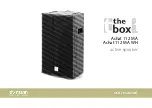
DRM
12A 2000W
12" Arr
ay
able P
ow
er
ed L
oudspeak
er
4
DRM12A 2000W 12" Arrayable Powered Loudspeaker
Introduction
The DRM12A 2000W 12" Arrayable Powered Loudspeaker
delivers class-leading power via an ultra-efficient Class-D
amplifier with next-gen protection and Power Factor
Correction technology for peak performance when you need
it.
Advanced Impulse™ DSP provides acoustic correction
and time-alignment via precision tuned FIR filters for crystal
clear, punchy sound typically experienced only with massive
touring systems. The DRM Control Dashboard™ features
a high-contrast, full-color display for quick access to EQ,
voicing modes and more.
A custom high-excursion 12" woofer and three 1" compression
drivers housed in the texture coated 15mm plywood cabinet
are designed for consistent performance in the most
demanding applications. The DRM12A is perfect for clubs,
houses of worship, rental systems and more.
While traditional point-and-shoot systems are great for
venues such as coffee houses and small clubs, they do not
have the output or throw to cover larger venues. In order to
compensate, venues often combine loudspeakers to get more
output and cover more ground. The problem is that the output
of these traditional loudspeakers overlap and interfere. This
interference is both constructive and destructive; it varies
depending upon the listening position. For many, what they
hear is less than desirable, and for no one it is exactly the
same.
A line array solves this problem by effectively channeling
these interferences, directing the sound where it is desired,
and removing it from where it is not. Today, line arrays are
the loudspeaker format of choice for high-profile tours and
large installs worldwide. Unlike traditional point-and-shoot
systems, line arrays excel at providing high output, long throw
and directional coverage with good vertical pattern control –
all in a package that is highly configurable and scalable.
But what is a line array system and how does it work? In
its simplest form, a line array is a group of closely spaced
loudspeakers arranged in a straight line. They are designed
such that constructive interference occurs in front of the
array of loudspeakers and destructive interference occurs
at the top and bottom. This is the highly desirable vertical
directivity for which line arrays are known.
However, one shouldn’t place just any ‘ol loudspeaker in a
line and expect to get increased output and better pattern
control. In order to get good vertical pattern control, a line
array must be designed so the transducers are positioned as
close together as possible. More specifically, the separation
between the transducers must be less than the wavelengths
emitted by them. This is easy to achieve for lower frequencies
with long wavelengths (e.g. 1 kHz is equal to 13.56 inches),
but much more difficult with higher frequencies (e.g. 10
kHz is equal to only 1.32 inches). Line arrays achieve this
tight spacing by using multiple drivers and more complex
mechanical designs. Even then, it isn’t practical to place
drivers only an inch apart. Therefore, additional acoustical
magic is employed in the horn design to flatten the
output of the high frequency wave fronts so they combine
constructively. The result is high output and even
coverage.
Well, if line arrays are so awesome, why even use traditional
loudspeakers any more? Simply because line arrays aren’t
perfect for all situations. A line array is best-suited to
applications where broad horizontal coverage is desired
throughout a given space, combined with long-throw and
higher output. Small venues don’t always need the added size
and output of a line array, and many meeting rooms, halls
and restaurants are better served by distributed systems
comprised of many small point-and-shoot loudspeakers.
Plus, the added cost for the more complex acoustical and
mechanical design of a line array puts them out of reach of
many customers...until now. The Mackie DRM12A brings this
technology to you at a price point never seen before.
The DRM12A is a constant curvature line array. This means
that the physical angle of the loudspeaker matches the
acoustical angle. There is only one way to rig together
multiple DRM12As, so it’s easy to use. As more units are
added, the array provides additional vertical coverage (plus
more vertical directivity at lower frequencies) and, of course,
it’s louder. DRM12A’s integrated rigging makes it perfect for
use in large permanent installs, tours and festivals where the
system is flown, or as a high-output pole-mounted portable
PA. The DRM12A is as versatile as your shows and will scale
to fit your needs like no other system anywhere else.
There is a lot to digest, so grab a coffee, cozy up into your
favorite chair and learn all there is to know about your new
DRM12A system.
THE EVER-IMPORTANT INSTALLATION WARNING
WARNING: DRM12A loudspeakers are
a wonderful tool when utilized in installed
and portable PA systems. However, improper
installation may result in damage to the equipment, injury
or even death. Therefore, installation should only be done
by experienced, licensed professionals to ensure that
the loudspeakers are installed in a stable and secure way
in order to avoid any conditions that may be dangerous
for persons or structures.





































